The Killer Tree You Should Never Have In Your Backyard
As an herbalist, I spend a lot of time planning the plants I want in my garden. And not so much time thinking about what I don’t want. However, it’s equally important to know what potentially dangerous plants you may have lurking in your backyard. Keep reading to learn about the killer trees you don’t want in your backyard.
If you like nuts, you might be considering planting a walnut tree in your yard. Walnut trees are great shade trees known for their beautiful wood and edible nuts. But be careful which variety of walnut you choose. Six varieties grow in the US. Make sure you avoid the Black Walnut, Juglans nigra. Here’s why.
Why Is It Bad?
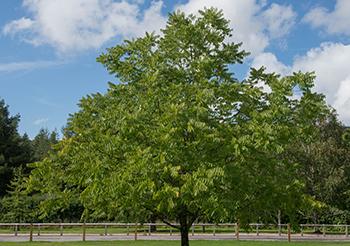 Black Walnut produces a chemical in its leaves, trunk, and roots called juglone. Juglone can cause damage or death to plants. While juglone is present in all walnut trees, the highest concentrations appear in the Black Walnut variety. Juglone helps protect walnut trees from other plants that may be competing for the same resources. So, while this is good for the Black Walnut tree, it is bad for you if you want to grow plants close by it. Juglone is concentrated in the soil beneath the drip line of the tree. The drip line is the area from the trunk to the edge of the branches. In a mature black walnut tree that can span 50 feet!
Black Walnut produces a chemical in its leaves, trunk, and roots called juglone. Juglone can cause damage or death to plants. While juglone is present in all walnut trees, the highest concentrations appear in the Black Walnut variety. Juglone helps protect walnut trees from other plants that may be competing for the same resources. So, while this is good for the Black Walnut tree, it is bad for you if you want to grow plants close by it. Juglone is concentrated in the soil beneath the drip line of the tree. The drip line is the area from the trunk to the edge of the branches. In a mature black walnut tree that can span 50 feet!
Some plants are more susceptible to juglone than others. If you do have a black walnut tree avoid planting these plants close by:
Distribution
Black Walnuts are native to Eastern North America. You can find the trees as far north as Ontario and as far south as Georgia and northern Florida. Their range reaches from the Atlantic Coast as far west as South Dakota and Texas.
How To Identify The Black Walnut Tree
All walnut trees have certain things in common. They are deciduous trees that can grow from 30- 131 feet tall. Their branches can span an epic 50 feet, making them a great choice for shade trees. All walnut trees produce a fruit- called a drupe- that contains an edible nut inside. In fact, those walnuts aren’t really nuts at all. They are the seeds of the fruit.
There are six different varieties of walnuts growing in the US. Black Walnut, along with English Walnut, is amongst the most common. So how do you tell one walnut variety from another?
Leaves
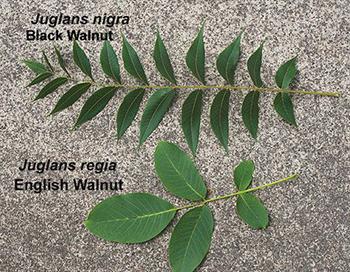 All species of walnuts have feathery pinnate leaves. The black walnut has between 15-23 leaflets on each twig. They are in pairs. The black walnut doesn’t have the extra leaf at the tip that other varieties have.
All species of walnuts have feathery pinnate leaves. The black walnut has between 15-23 leaflets on each twig. They are in pairs. The black walnut doesn’t have the extra leaf at the tip that other varieties have.
This leaf is the easiest way to distinguish black walnut from other species. When the black walnut does have a terminal leaf, it is small. The similar English and butternut walnuts always have a large terminal leaf.
Trunk
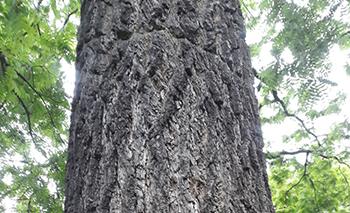 Black walnut bark is dark and deeply fissured. If you remove the bark, you can see the dark brown wood beneath it. The bark on the black walnut is darker than the bark on other walnut varieties. The deep ridges in the bark are the most distinctive feature of this tree in winter. You can see diamond-shaped patterns in the ridges in the bark.
Black walnut bark is dark and deeply fissured. If you remove the bark, you can see the dark brown wood beneath it. The bark on the black walnut is darker than the bark on other walnut varieties. The deep ridges in the bark are the most distinctive feature of this tree in winter. You can see diamond-shaped patterns in the ridges in the bark.
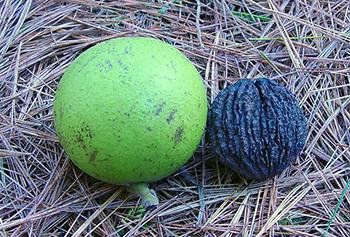
Nuts
The nuts’ shape varies depending on which variety of walnut you have.
Black walnuts are round rather than oval like the butternut variety. Black walnuts also have the hardest shells.
Benefits
If you do have a black walnut tree, it is not all bad. There are benefits of having this tree in your yard. The main one is the delicious nuts.
Walnuts are high in antioxidants and Omega-3s. This can help improve any inflammatory conditions you may have. They also have been shown to help with brain health, diabetes, high blood pressure, and high cholesterol. They are easy to add to your diet. You can snack on just walnuts or try adding them to your food. They are great in salads, trail mix, with fruit or vegetables. The possibilities are endless.
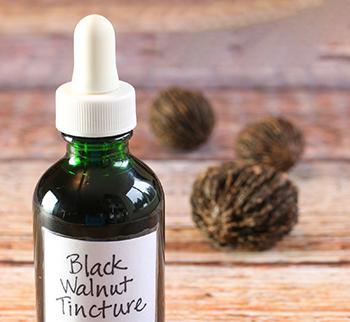
There are also many ways to use walnuts besides eating them. The wood is beautiful and strong, so it is a popular choice. Walnut oil can be eaten or used to make non-toxic oil-based paints. The hulls have many uses as well. They can be used as a dye, ground up and added to cosmetics, or used medicinally as an anti-parasitic.
So while walnuts can be killer to your plants, they have many beneficial uses as well. Unlike the Manchineel tree, which I’ll talk about next.
Manchineel Tree
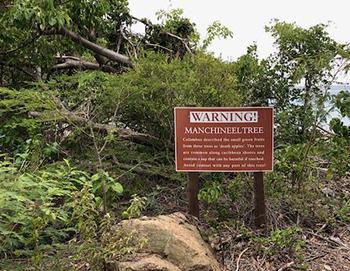 The manchineel tree, Hippomane mancinella, is native to the tropical regions of southern North America and northern South America. In the US, it is found only in Florida. It grows mostly along beaches or in swampy areas. It grows as tall as 50 feet tall and has fruit that resembles small green apples.
The manchineel tree, Hippomane mancinella, is native to the tropical regions of southern North America and northern South America. In the US, it is found only in Florida. It grows mostly along beaches or in swampy areas. It grows as tall as 50 feet tall and has fruit that resembles small green apples.
Because of these fruits, it is also called manzanilla de la muerte in Spanish, which translates to “little apple of death.” When it comes to toxic trees, this tree is one of the most toxic in the world. The sap is the real problem. The milky white fluid contains numerous poisons and is present in all parts of the tree. This burning sap is so toxic that simply standing under the tree during a rainstorm can cause blistering as the sap dissolves into the rain. Eating the fruit can cause death.
When planning your garden, remember to pay as much attention to the killer trees as you do to the beneficial plants. Some killer trees, like black walnut, may have benefits you decide outweigh the risks. Others, like the manchineel tree, are so toxic it’s best to avoid them together.
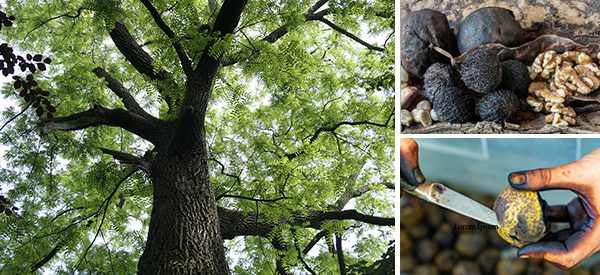
Comments
Post a Comment